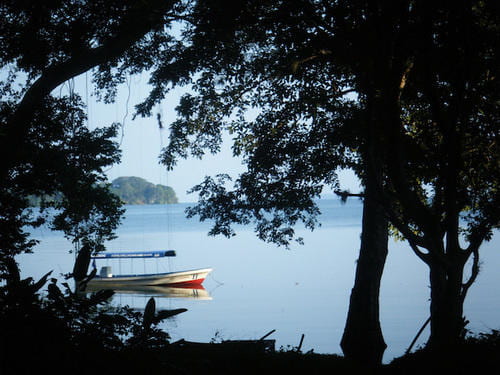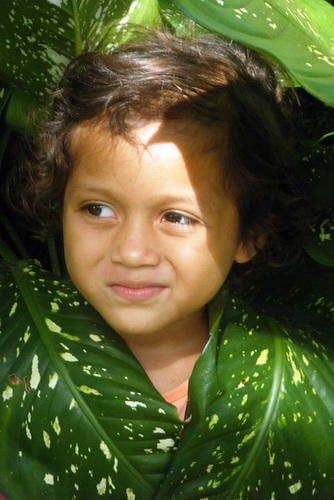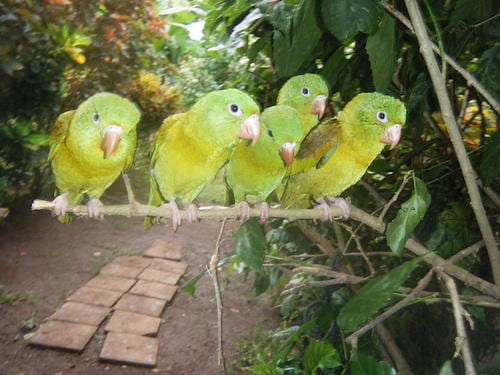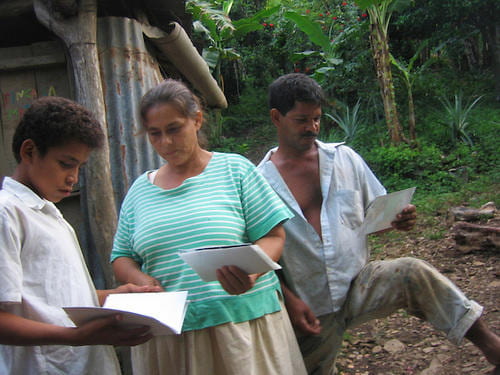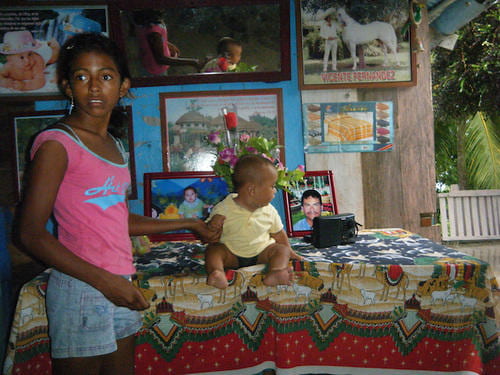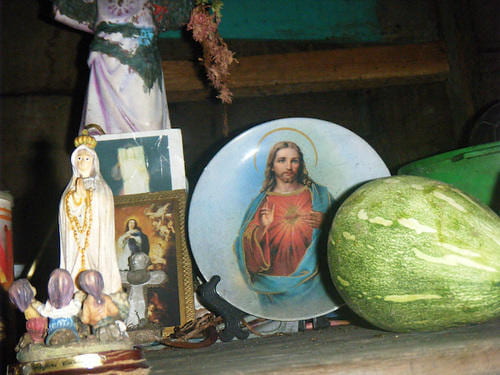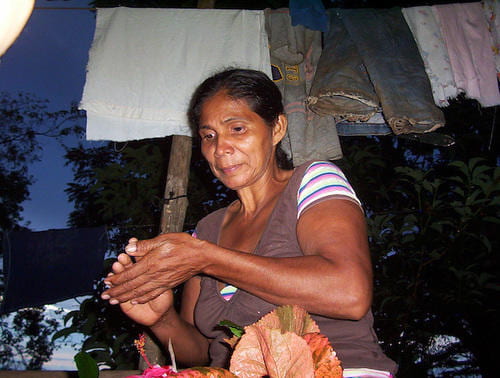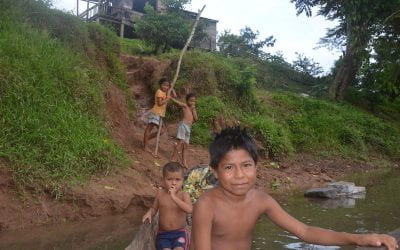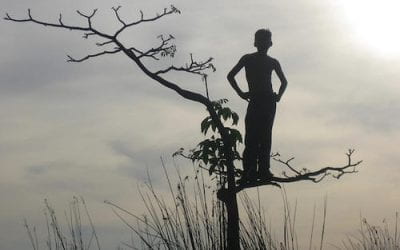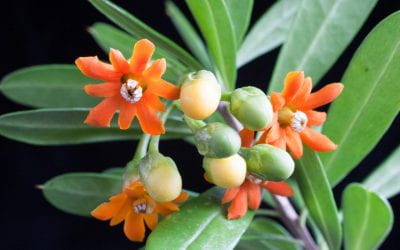Solentiname Reflected
Photos by the youth of Solentiname under the guidance of Tiago Genoveze
I became a priest in order to found a small contemplative community on an island in the archipelago of Solentiname in Lake Nicaragua. In the twelve and a half years that we maintained our small community in Solentiname we received a great many visitors, from Nicaragua and abroad. Sometimes there were so many that we regretted not to be able to host any more; then, in the distance, we would see others arriving at our small dock with their luggage and backpacks. There were even times when they arrived in Solentiname without even passing through the capital of Managua: traveling to Costa Rica and entering Lake Nicaragua via the Rio San Juan.
There are also a great number of people (besides myself) who have written about Solentiname. And as I have said many times: Solentiname has been made into a sort of myth. Our accomplishments there and the experiences that took place there were not as important as they have often been portrayed. It was all actually quite modest.
The book The Gospel According to Solentiname –-composed of commentaries on the Gospel made by campesinos together with me, and also with many visitors’ participation–-is what has most contributed to Solentiname’s recognition throughout the world. Some of the commentaries were so good that I decided to capture them on a tape recorder and publish them later in a book. The book has gone through a great many editions and has been translated into many languages, including Japanese, Filipino and Korean. Commenting on the Gospel collectively, the way it was done in Solentiname, was later replicated in other places, especially in Protestant parishes in the United States (where once I was invited to teach this practice to a community). It was a Spanish priest who visited us in Solentiname who taught me how he did it in a poor neighborhood in Managua, and he had learned it from a Panamanian priest who had learned the practice from a priest from Chicago.
One cannot deny the importance of some of Solentiname’s other successes, but they were mostly consequences of others’ efforts rather than my own. The primitivist paintings of Solentiname’s campesinos began when the painter Róger Pérez de la Rocha and I gave paper and colored pencils to a peasant, then canvas, paintbrushes and oil paint, and he created the first paintings. That is the origin of the great quantity of Solentiname’s painters, whose works have become famous and influential throughout all of Nicaragua.
The handicrafts made from balsa wood, which have also contributed to Solentiname’s fame, began with a 13-year-old campesino boy named Eufredito, a son of a day laborer who occasionally worked alongside his father as a day laborer himself. Eufredito began carving miniature figures into the soft and light balsa wood using a Gillete razor blade, after having seen some of my wooden sculptures. The figures he made were influenced by mine, which are modern stylistically, though his were naïve, primitive and very charming. I offered him money for each sculpture he made; seeing this, other campesinos began bringing me their own balsa wood figures (fish, herons, armadillos, squirrels, turtles), which I paid for as well. That’s how the famed handicraft that has become so abundant in Solentiname began; and it too has borne its influence in other parts of Nicaragua.
Solentiname has also produced great campesino poetry, which has been published in several places and translated to other languages. The emergence of this poetry was purely coincidental. Upon visiting Solentiname, the Costa Rican writer Mayra Jiménez realized that the campesinos were not familiar with my poetry. I had never presented it to them because I thought they would not understand it, and most of them were not even aware that I was a poet (and even the word “poet” would not mean very much to them). Mayra Jiménez had already taught poetry workshops to children and decided to organize a workshop for the local campesinos with the objective of presenting some of my poetry, as well as poetry written by some other Nicaraguan authors, and even of stimulating them to create their own poems. She fulfilled the objectives of her workshop and, most importantly, ignited the production of Solentiname’s own campesino poetry.
I have often referred to these four achievements as “miracles” because they happened unexpectedly, without my ever having planned them at all. Now we may talk about a fifth miracle: the photography made by the children of Solentiname; which is also something I have had no participation in. “Solentiname Reflected” has a very singular story: a 23-year-old Brazilian studying in the United States decided to go to Solentiname and distribute cameras to the campesino children so that they could make their own pictures.
He knew practically nothing about Solentiname before his journey. Dissatisfied with his overly comfortable life at Boston University, he yearned for an adventure, something that could give his life more meaning. It was at this moment that he was moved by a documentary he had seen called Born into Brothels, which related the story of a photographer who moved to Calcutta to document the prostitutes of the red-light district; as she worked, she built friendships among the prostitutes’ children and began teaching them photography. The children’s pictures were exhibited and well received. Upon watching the film, Tiago, the young photographer, felt as though he had found the direction he had so eagerly been seeking: teach photography workshops to children who had never before touched a camera.
It was also during this time that he recalled an essay he had written in one of his literature classes in which he analyzed my poem “Apocalypse” as well as Julio Cortázar’s short story “Apocalypse at Solentiname”. Cortázar’s short story caught his attention because of its connection with photography and with Solentiname, and that’s when he discovered that I was one of the story’s characters. Before that moment, however, he had never read about me; and he had never heard of Solentiname. He also did not know a thing about Nicaragua, though, over time, he began to learn about the revolution, liberation theology and Solentiname. According to him, he had never imagined that my poem and that short story would take him to Solentiname. Later, however, as he learned more about the islands, he decided that was where he wanted to initiate his project. He made some contacts on the Internet and, three months later, arrived on our dock with his cameras.
The cameras, donated by friends and acquaintances, were used and a bit outdated, but in perfect working order. A $1,000 donation made by a friend from New York allowed for the purchase of several new cameras as well. Tiago agrees with me that this experiment was about democratizing art and technology. “Besides teaching some basic concepts and principles,” he says, “all I had to do was put the cameras in their hands.”
The children reacted with great enthusiasm and curiosity. For the vast majority of them, it was the first time they had touched a camera. Up until then, cameras had been something only foreigners and tourists used.
To Tiago’s surprise, despite the islands’ excessive humidity and tropical climate, despite the daily use of the cameras and the children’s manner of handling them—running, jumping and playing everywhere they went—, only one camera was damaged over the year-long experiment, and it was not due to the operator’s carelessness. When Tiago arrived, several people predicted that the cameras would not last long because the kids would either break them or steal them. Neither thing happened. In spite of their boisterous nature, the kids took care of the cameras as if they actually belonged to them.
Tiago taught them how to use the cameras’ basic functions and gave them 45 minutes to take pictures. He observed that upon receiving the cameras everyone did the same thing: they stepped outside and began inspecting the world around them as though they had never seen it before–and all because they now had a camera in their hands. “I was deeply impressed by this,” he says, “and I took it as proof that despite our familiarity with our environment, we must study it in order to photograph it, which can lead us to an elevated state of observation that allows us to see things that were invisible to us before the camera was in our grasp.”
These pictures have, according to Tiago, a singular documentary and artistic value. They compose a collective panorama of the archipelago as seen from within. The children with cameras in hand were like mirrors of their own reality, in which reality there are surely few mirrors, often small and stowed away, within the poor houses. The kids were itinerant mirrors, says Tiago. They took pictures everywhere they went and showed them to everyone who happened to be nearby.
Another value of these pictures—also according to Tiago—is the sheer multiplicity of perspectives and representation of diverse realities of local life, resulting in a demystification of Solentiname. “These pictures,” he tells me, “reveal the everyday Solentiname as it is now, which is very different from what can be read about it in books and from the Solentiname that you founded. For the first time we are able to see Solentiname’s real protagonists as portrayed by themselves.”
Tiago would organize photographic critique sessions once a month or every two months. The purpose was to look through a selection of recent pictures and talk about them in order to sharpen the participants’ senses. At first, the children had difficulty in expressing themselves. Ultimately, after prolonged silences, somebody would dare say that a picture was pretty or ugly, but they couldn’t say why.
The children were also receiving reading classes where books were not only read but also discussed in groups; writing exercises were assigned as well. Tiago taught the photography workshops as a follow-up activity, and one could only participate if one had attended the preceding reading workshop, which motivated the children to attend both.
The kids’ enthusiasm and participation in the project revealed their love for photography. They walked about happily with their cameras, taking pictures of everything in their paths, reviewing them on the screens, and then showing the images to their parents, grandparents, cousins, neighbors and friends.
On certain workshops he would say that he only wanted to see portraits, or landscapes, or that the kids should try to get as close to their subjects as possible; but most of the time he would give them the liberty to photograph whatever they wanted. And that is how some of the most interesting pictures were made. The children had to return the cameras as soon as sessions were over, though sometimes they kept their cameras for a whole day in order to experiment with night photography.
This was not about training the kids to be professional photographers. What Tiago wanted was for the children to have fun with a new manner of self-expression. He says that the children’s pictures changed his relationship with photography. Their images made him look at his own work in a different light. While the kids shot in a completely spontaneous manner, Tiago photographed according to the instructions received throughout his formal education. By immersing himself in his studies he had forgotten about the beauty of photographing spontaneously, without rules or esthetic principles.
Tiago—whom I met just as he was finishing his project—also reflects upon how a few works of art led him to a practically forgotten corner of the planet, completely changing his life as well as influencing the lives of the residents of Solentiname. There’s an important lesson for him here: we must keep ourselves sensitive to the changes that any artistic medium can instigate within us. Art should not only be appreciated esthetically or intellectually; it should lead us to action, to work for the benefit of others.
This is what has led him to share his project with others in the book, “Solentiname Reflected.” Who knows, he says, if the book will also help to determine a future reader’s path.
For me, this has been the fifth miracle of Solentiname.
For more information about this project, view the Miradas de Solentiname website, or download the ebook here.
Miradas de Solentiname: Fotografías y Reflexiones
Por Ernesto Cardenal
Con fotos de la juventud de Solentiname bajo la dirección de Tiago Genovese
Yo me hice sacerdote para fundar una pequeña comunidad contemplativa en una isla del archipiélago de Solentiname en el Lago de Nicaragua. En los doce años y medio que tuvimos nuestra pequeña comunidad en Solentiname fueron muchísimos los visitantes que llegaron, de Nicaragua y el extranjero. Tantos que a veces nos afligíamos porque ya no podíamos hospedar más, y veíamos desde lejos que arrimaban otros a nuestro pequeño muelle con maletas o mochilas. Hubo casos en que llegaban a Solentiname sin pasar por la capital Managua: viajando a Costa Rica y entrando por el Río San Juan al Lago de Nicaragua.
También son muchos los que (además de mí) han escrito sobre Solentiname. Y, como yo he dicho muchas veces: se ha hecho de Solentiname una especie de mito. La experiencia que allí hubo y lo que allí realizamos no tiene la importancia que muchas veces se le ha dado. Fue en realidad algo muy modesto.
Lo que ha hecho más conocido Solentiname en el mundo es el libro El Evangelio en Solentiname, comentarios del Evangelio hechos por los campesinos junto conmigo, y también con la participación de muchos visitantes. Los comentarios eran a veces tan buenos que yo decidí recogerlos en grabadora y después publicarlos en libro. Este libro ha tenido muchas ediciones y ha sido traducido en muchas lenguas, aun el japonés, el filipino, el coreano. El comentar el Evangelio colectivamente como se hizo en Solentiname se ha repetido después en otras partes, sobre todo en parroquias protestantes en Estados Unidos (adonde fui invitado una vez para que enseñara a hacerlo a una comunidad). Fue un sacerdote español que nos visitó en Solentiname el que me enseñó a mí a hacerlo, como él lo practicaba en un barrio pobre en Managua, y lo había aprendido de un sacerdote panameño que a su vez lo había aprendido de un sacerdote de Chicago.
No se puede negar la importancia de otros logros de Solentiname, pero fueron debidos no tanto a mí sino más bien a otros. La pintura primitiva de los campesinos de Solentiname se inició cuando el pintor Róger Pérez de la Rocha y yo dimos a un campesino papel y lápices de colores, y después telas y pinceles y óleos, y éste pintó los primeros cuadros. De ahí procede la gran cantidad de pintores que ha habido en Solentiname, cuya pintura se ha hecho célebre y ha influido en todo Nicaragua.
La artesanía de madera de balso que también ha hecho famoso a Solentiname la originó un niño campesino de 13 años, Eufredito. Hijo de un jornalero, y él mismo a veces también jornalero junto con su padre, viendo las esculturas en madera que yo hacía, se puso a labrar con una cuchilla Gillet pequeñas figuritas en madera de balso, que es muy suave y liviana. Sus figuras estaban influidas por las mías, que son estilizaciones modernas; aunque las de él eran ingenuas y primitivas, y con mucha gracia. Yo le ofrecí dinero por cada escultura que hacía, y viendo eso otros campesinos empezaron a llevarme figuras hechas por ellos también en madera de balso (pescados, garzas, armadillos, ardillas, tortugas) las que yo también pagaba; y así se generó la famosa artesanía, ahora muy abundante en Solentiname, y que también ha influido en otras partes de Nicaragua.
Solentiname también produjo una muy buena poesía campesina, que se ha publicado en otras partes y se ha traducido a otros idiomas. La aparición de esa poesía se debió a pura casualidad. La escritora costarricense Mayra Jiménez que nos visitó en Solentiname, se dio cuenta que los campesinos de allí no conocían mi poesía. Yo no se las había dado a conocer porque pensaba que no la comprenderían, y la gran mayoría de ellos ni siquiera sabían que yo era poeta (y aun la palabra poeta no tendría para ellos mucho significado). Mayra Jiménez había hecho ya antes algunos talleres de poesía para niños, y resolvió hacer en este lugar uno para los campesinos, con el objeto de que conocieran mi poesía y la de algunos otros poetas nicaragüenses, y que además pudieran empezar a escribir poesía ellos mismos. Todo esto se logró en su taller, y lo más importante es que se produjo la poesía campesina de Solentiname.
Varias veces me he referido a estos cuatro logros llamándoles “milagros”, porque se habían producido sorpresivamente, y sin que yo los hubiera en lo absoluto planificado. Ahora se puede hablar de un quinto milagro: el de la fotografía de los niños y las niñas de Solentiname; que es también algo en lo que yo no he tenido ninguna participación.
Miradas de Solentiname tiene una historia muy singular. Resultó que un joven fotógrafo brasileño de 23 años, que estaba estudiando en Estados Unidos, decidió ir a Solentiname y dar cámaras fotográficas a los niños campesinos para que tomaran sus propias fotografías.
Anteriormente él no había sabido nada de Solentiname. Estaba insatisfecho de su vida de mucho confort en la Universidad de Boston. Deseaba, en vez de ella, emprender alguna aventura, algo que le diera más sentido a su vida. Entonces le impactó un documental llamado Born into Brothels(“Los niños del barrio rojo”) que trataba de cómo una fotógrafa había ido a Calcuta a fotografiar las prostitutas de la Zona Roja, y mientras lo realizaba empezó a hacerse amiga de los niños de ellas, y les dio cámaras para que aprendieran como un oficio la fotografía. Las fotos de los niños fueron expuestas y gustaron mucho. Todo esto estaba relatado en el documental, y el joven fotógrafo Tiago sintió encontrar en él el rumbo que afanosamente había andado buscando: hacer talleres de fotografía con niños y niñas que jamás hubieran tocado una cámara.
En esos días se acordó de un ensayo que había escrito para su clase de literatura, en el que analizaba mi poema Apocalipsis y el cuento de Julio Cortázar Apocalipsis en Solentiname. En el cuento de Cortázar le había llamado la atención su relación con la fotografía y con Solentiname, y allí descubrió que yo era uno de los personajes del cuento. Pero anteriormente él no había leído nada sobre mí. Ni nunca había oído hablar de Solentiname. Tampoco sabía nada de Nicaragua, aunque poco a poco fue sabiendo algo sobre la revolución, sobre la teología de la liberación y sobre Solentiname. Jamás pensó, dice él, que ese poema mío y ese cuento lo iban a llevar a Solentiname. Después se fue informando más y resolvió realizar allí su proyecto. Tuvo un contacto en Internet, y tres meses después estaba desembarcando con sus cámaras en nuestro muelle.
Las cámaras viejas donadas por amigos y conocidos ya se encontraban un poco anticuadas pero aún funcionaban perfectamente. Otras cámaras habían sido compradas por él mediante una donación de mil dólares que le hizo un amigo de Nueva York. Tiago está de acuerdo conmigo en que este experimento como una democratización del arte y la tecnología. Y dice él: “Fuera de enseñarles algunos conceptos y preceptos básicos, la única cosa que tuve que hacer fue poner las cámaras en sus manos”.
Los niños y niñas reaccionaron con gran entusiasmo y curiosidad. Para la gran mayoría de ellos era la primera vez que tocaban una cámara. Hasta entonces las cámaras fotográficas eran algo que sólo los extranjeros y los turistas podían manejar.
Para Tiago es sorprendente el que a pesar de la excesiva humedad de las islas, en aquel clima tropical, del uso diario de las cámaras y la manera en que los chavalos las llevaran por todos lados, corriendo, brincando y jugando, sólo una cámara se dañó en todo el año en que se hizo el experimento, y no fue por culpa del operador. Cuando él llegó no faltaron quienes vaticinaran que las cámaras no durarían mucho tiempo, porque los chavalos [niños] las iban a descomponer o las robarían. Ninguna de las dos cosas sucedió. A pesar de la manera bulliciosa de fotografiar cuidaron de las cámaras como si en realidad les pertenecieran.
Él les enseñó las funciones más básicas de la cámara, y les dio 45 minutos para que fotografiaran. Observó que al momento de recibir las cámaras todos hacían lo mismo: salieron afuera y se pusieron a inspeccionar el mundo a su alrededor como si por el hecho de tener una cámara lo miraran por primera vez. “Esto me impresionó muchísimo” –dice—“y lo vi como prueba de que a pesar de nuestra familiaridad con lo que nos rodea, para fotografiarlo necesitamos estudiarlo, y esto nos puede llevar a un estado elevado de observación que nos hace ver cosas que nos eran invisibles antes de tener una cámara en nuestras manos”.
Estas fotos tienen un valor documental y artístico único según Tiago. Constituyen una visión colectiva del archipiélago realizada desde dentro. Los niños con sus cámaras fueron como espejos de su propia realidad, en la que por cierto hay pocos espejos, a menudo pequeñitos, arrinconados en sus pobres casas. Los chavalos fueron espejos ambulantes, dice Tiago. Dondequiera que iban sacaban fotos y se las mostraban a todos los que estaban a su alrededor.
Otro valor de estas imágenes, también me dice él, es el de la multiplicidad de sus miradas, presentando las diversas realidades de su vida, y de esta manera desmitificando Solentiname. “Estas fotos” –me dice— “revelan el Solentiname cotidiano de hoy, muy distinto del que se lee en los libros y del Solentiname que usted fundó. Por primera vez vemos los protagonistas del Solentiname real retratados por ellos mismos”.
Una vez por mes o cada dos meses Tiago organizaba una sesión de crítica sobre las fotos. El objeto era ver una selección de fotos recientemente hechas y hablar sobre ellas para agudizar su percepción. Al principio los niños tenían mucha dificultad en expresarse. A lo sumo, después de muchos silencios alguien se atrevía a decir de una foto que estaba bonita o fea. Pero no podía decir por qué.
Los niños estaban teniendo unas clases de lecturas en grupos, donde además de leer libros los discutían después de leídos, y también tenían ejercicios de escritura. Tiago les hacía el taller de fotografía a continuación. Ningún niño podía participar en ellos si no había asistido antes al taller de lectura, para que los niños asistieran a él.
Los niños participaban con gran entusiasmo en el proyecto porque les encantaba fotografiar. Salían felices con cámaras en sus manos, tomando fotos a todo lo que encontraban, y mirando las fotos en las pantallas de sus cámaras, y después mostrando las imágenes a sus padres, abuelos, primos, vecinos y amigos.
En los talleres a veces les decía que quería sólo fotos de rostros, o que acercaran lo más posible la cámara al objeto, o que quería sólo paisajes. Pero la mayoría de las veces los dejaba en libertad de fotografiar lo que quisieran. Y muchas de las fotos más curiosas fueron estas. Los niños debían regresar las cámaras en cuanto terminaba la sesión, pero a veces les permitía que tuvieran la cámara por 24 horas para que experimentaran con fotos nocturnas.
No se trataba de capacitar a los niños para que fueran fotógrafos profesionales. Lo que él quería era que se divirtieran con una nueva forma de expresión. Él dice que las fotos de los niños y las niñas cambiaron su relación con la fotografía. Esas fotos le hicieron ver las suyas bajo otra luz. Mientras los niños fotografiaban de forma completamente espontánea, él lo hacía según las enseñanzas que había recibido.
También me dice Tiago, a quien yo llegué a conocer hasta que estaba terminado su proyecto, que el hecho de que unas obras de arte lo llevaran a un rincón prácticamente olvidado del mundo, y que con ello cambiara su vida y también influyera en la de los solentinameños, es para él una lección muy importante. La lección de que hay que ser sensibles a los cambios que cualquier medio artístico puede provocar en nosotros. Que el arte no se debe apreciar solamente en forma estética e intelectual, sino que también nos debe llevar a la acción, y a hacer obras en beneficio de los demás.
Esto es lo que ha llevado a él a compartir su proyecto con otras personas en el libro Miradas de Solentiname. Quién sabe, dice él, si este libro servirá también para determinar el rumbo de la vida de uno de sus futuros lectores.
Para mí ha sido el quinto milagro de Solentiname.
Para más información sobre este proyecto, ver el sitio web de Miradas de Solentiname, o descargar el ebook.
Spring/Summer 2019, Volume XVIII, Number 3
Ernesto Cardenal (1925) is a Nicaraguan priest, poet, and sculptor who founded his contemplative community in Solentiname in 1966. His work has been translated to more than 20 languages. He was Culture Minister of Nicaragua from 1979-1987. This article was translated by Tiago Genoveze, revised by Dennis Costa, and adapted by June Carolyn Erlick.
Ernesto Cardenal (1925) es un poeta, sacerdote y escultor nicaragüense que fundó su comunidad contemplativa en Solentiname en 1966. Su obra ha sido traducida a más de veinte idiomas. Fue Ministro de Cultura en Nicaragua desde 1979 a 1987.
Related Articles
Accompanying a Search for Self-Determination
English + Español
The small indigenous Mayagna community of Awas Tingni in the interior forest of Nicaragua’s Caribbean Coast made legal history in the 1990s when they faced an incursion by an international lumber company. The community mapped its land claims and brought a case…
The Afterlife of Rubén Darío in English
English + Español
Argentine writer Enrique Anderson Imbert (1910–2000)—who, incidentally, in 1965 became the first Victor S. Thomas Professor of Hispanic Literature at Harvard—once wrote that the Nicaraguan poet Rubén Darío divides the history of Spanish-language literature in…
Ambivalent Memories
English + Español
On July 20, 1979, the dawn after the triumph of the Sandinista Revolution, I had the good fortune to arrive in Managua as an assistant for a Dutch TV crew. As for anyone who lived through those days, the experience overwhelmed my senses—the palpable collective joy tempered…

